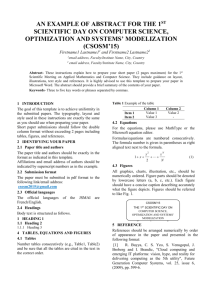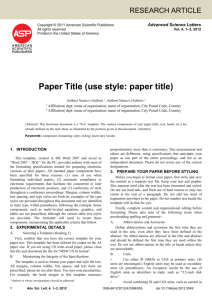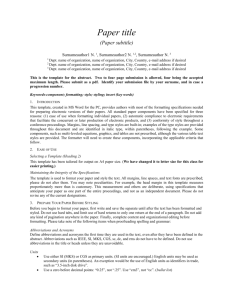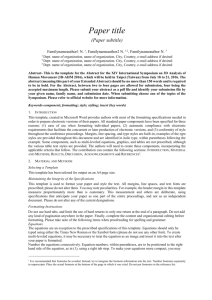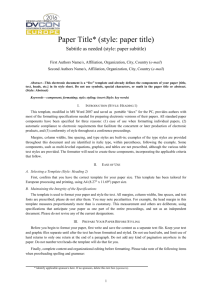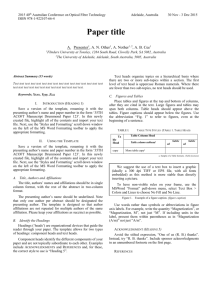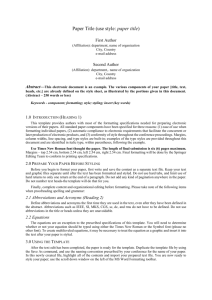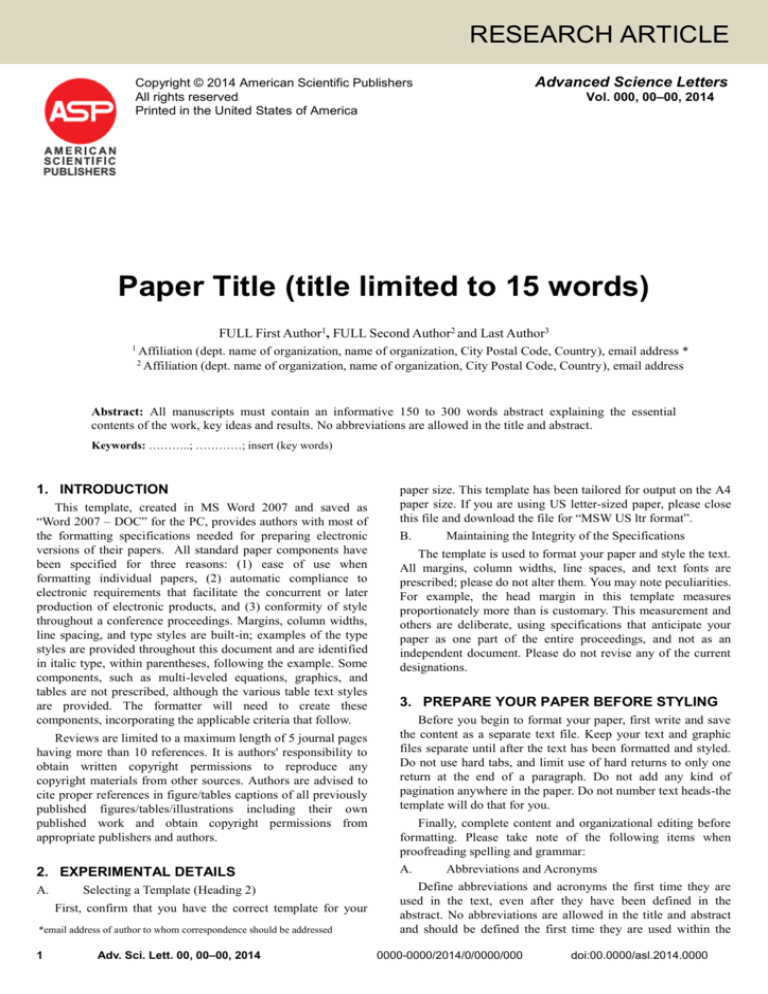
RESEARCH ARTICLE
Advanced Science Letters
Copyright © 2014 American Scientific Publishers
All rights reserved
Printed in the United States of America
Vol. 000, 00–00, 2014
Paper Title (title limited to 15 words)
FULL First Author1, FULL Second Author2 and Last Author3
1
Affiliation (dept. name of organization, name of organization, City Postal Code, Country), email address *
Affiliation (dept. name of organization, name of organization, City Postal Code, Country), email address
2
Abstract: All manuscripts must contain an informative 150 to 300 words abstract explaining the essential
contents of the work, key ideas and results. No abbreviations are allowed in the title and abstract.
Keywords: ………..; …………; insert (key words)
1. INTRODUCTION
This template, created in MS Word 2007 and saved as
“Word 2007 – DOC” for the PC, provides authors with most of
the formatting specifications needed for preparing electronic
versions of their papers. All standard paper components have
been specified for three reasons: (1) ease of use when
formatting individual papers, (2) automatic compliance to
electronic requirements that facilitate the concurrent or later
production of electronic products, and (3) conformity of style
throughout a conference proceedings. Margins, column widths,
line spacing, and type styles are built-in; examples of the type
styles are provided throughout this document and are identified
in italic type, within parentheses, following the example. Some
components, such as multi-leveled equations, graphics, and
tables are not prescribed, although the various table text styles
are provided. The formatter will need to create these
components, incorporating the applicable criteria that follow.
Reviews are limited to a maximum length of 5 journal pages
having more than 10 references. It is authors' responsibility to
obtain written copyright permissions to reproduce any
copyright materials from other sources. Authors are advised to
cite proper references in figure/tables captions of all previously
published figures/tables/illustrations including their own
published work and obtain copyright permissions from
appropriate publishers and authors.
paper size. This template has been tailored for output on the A4
paper size. If you are using US letter-sized paper, please close
this file and download the file for “MSW US ltr format”.
B.
Maintaining the Integrity of the Specifications
The template is used to format your paper and style the text.
All margins, column widths, line spaces, and text fonts are
prescribed; please do not alter them. You may note peculiarities.
For example, the head margin in this template measures
proportionately more than is customary. This measurement and
others are deliberate, using specifications that anticipate your
paper as one part of the entire proceedings, and not as an
independent document. Please do not revise any of the current
designations.
3. PREPARE YOUR PAPER BEFORE STYLING
Before you begin to format your paper, first write and save
the content as a separate text file. Keep your text and graphic
files separate until after the text has been formatted and styled.
Do not use hard tabs, and limit use of hard returns to only one
return at the end of a paragraph. Do not add any kind of
pagination anywhere in the paper. Do not number text heads-the
template will do that for you.
Finally, complete content and organizational editing before
formatting. Please take note of the following items when
proofreading spelling and grammar:
2. EXPERIMENTAL DETAILS
A.
A.
Define abbreviations and acronyms the first time they are
used in the text, even after they have been defined in the
abstract. No abbreviations are allowed in the title and abstract
and should be defined the first time they are used within the
Selecting a Template (Heading 2)
First, confirm that you have the correct template for your
*email address of author to whom correspondence should be addressed
1
Adv. Sci. Lett. 00, 00–00, 2014
Abbreviations and Acronyms
0000-0000/2014/0/0000/000
doi:00.0000/asl.2014.0000
RESEARCH ARTICLE
Adv. Sci. Lett. 00, 00–00, 2014
text. Do not use abbreviations in the title or heads unless they
are unavoidable. The "Advanced Science Letters" should be
abbreviated as Adv. Sci. Lett., for the citation purpose.
B.
Units
•
Use either SI (MKS) or CGS as primary units. (SI
units are encouraged.) English units may be used as secondary
units (in parentheses). An exception would be the use of
English units as identifiers in trade, such as “3.5-inch disk
drive”.
•
Avoid combining SI and CGS units, such as current in
amperes and magnetic field in oersteds. This often leads to
confusion because equations do not balance dimensionally. If
you must use mixed units, clearly state the units for each
quantity that you use in an equation.
•
Do not mix complete spellings and abbreviations of
units: “Wb/m2” or “webers per square meter”, not “webers/m2”.
Spell out units when they appear in text: “. . . a few henries”,
not “. . . a few H”.
•
Use a zero before decimal points: “0.25”, not “.25”.
Use “cm3”, not “cc”. (bullet list)
C.
Equations
The equations are an exception to the prescribed
specifications of this template. You will need to determine
whether or not your equation should be typed using either the
Times New Roman or the Symbol font (please no other font).
To create multileveled equations, it may be necessary to treat
the equation as a graphic and insert it into the text after your
paper is styled.
Number equations consecutively. Equation numbers, within
parentheses, are to position flush right, as in (1), using a right
tab stop. To make your equations more compact, you may use
the solidus ( / ), the exp function, or appropriate exponents.
Italicize Roman symbols for quantities and variables, but not
Greek symbols. Use a long dash rather than a hyphen for a
minus sign. Punctuate equations with commas or periods when
they are part of a sentence, as in
⑴
Note that the equation is centered using a center tab stop. Be
sure that the symbols in your equation have been defined before
or immediately following the equation. Use “(1)”, not “Eq. (1)”
or “equation (1)”, except at the beginning of a sentence:
“Equation (1) is . . .”
D.
Some Common Mistakes
•
The word “data” is plural, not singular.
•
other common scientific constants, is zero with subscript
formatting, not a lowercase letter “o”.
•
In American English, commas, semi-/colons, periods,
question and exclamation marks are located within quotation
marks only when a complete thought or name is cited, such as a
title or full quotation. When quotation marks are used, instead
of a bold or italic typeface, to highlight a word or phrase,
punctuation should appear outside of the quotation marks. A
parenthetical phrase or statement at the end of a sentence is
punctuated outside of the closing parenthesis (like this). (A
parenthetical sentence is punctuated within the parentheses.)
•
A graph within a graph is an “inset”, not an “insert”.
The word alternatively is preferred to the word “alternately”
(unless you really mean something that alternates).
•
Do not use the word “essentially”
“approximately” or “effectively”.
to
mean
•
In your paper title, if the words “that uses” can
accurately replace the word “using”, capitalize the “u”; if not,
keep using lower-cased.
•
Be aware of the different meanings of the homophones
“affect” and “effect”, “complement” and “compliment”,
“discreet” and “discrete”, “principal” and “principle”.
•
Do not confuse “imply” and “infer”.
•
The prefix “non” is not a word; it should be joined to
the word it modifies, usually without a hyphen.
•
There is no period after the “et” in the Latin
abbreviation “et al.”.
•
The abbreviation “i.e.” means “that is”, and the
abbreviation “e.g.” means “for example”.
4. USING THE TEMPLATE
After the text edit has been completed, the paper is ready for
the template. Duplicate the template file by using the Save As
command, and use the naming convention prescribed by your
conference for the name of your paper. In this newly created
file, highlight all of the contents and import your prepared text
file. You are now ready to style your paper; use the scroll down
window on the left of the MS Word Formatting toolbar.
A.
Authors and Affiliations
The template is designed so that author affiliations are not
repeated each time for multiple authors of the same affiliation.
Please keep your affiliations as succinct as possible (for
example, do not differentiate among departments of the same
organization). This template was designed for two affiliations.
B.
Identify the Headings
Headings, or heads, are organizational devices that guide the
reader through your paper. There are two types: component
heads and text heads.
Component heads identify the different components of your
paper and are not topically subordinate to each other. Examples
include ACKNOWLEDGMENTS and REFERENCES and, for
these, the correct style to use is “Heading 5”. Use “figure
caption” for your Figure captions, and “table head” for your
table title. Run-in heads, such as “Abstract”, will require you to
apply a style (in this case, italic) in addition to the style
provided by the drop down menu to differentiate the head from
the text.
Text heads organize the topics on a relational, hierarchical
basis. For example, the paper title is the primary text head
because all subsequent material relates and elaborates on this
one topic. If there are two or more sub-topics, the next level
head (uppercase Roman numerals) should be used and,
conversely, if there are not at least two sub-topics, then no
subheads should be introduced. Styles named “Heading 1”,
“Heading 2”, “Heading 3”, and “Heading 4” are prescribed.
FIGURES: It is very important to supply high quality
figures in a form suitable for reproduction. All figures, tables,
illustrations, photographs should be prepared in such a way that
they could be printed in a single column size with a width of 3
2
RESEARCH ARTICLE
Adv. Sci. Lett. 00, 00–00, 2014
1/4 inches or 8.25 cm. Use 12 ARIAL BOLD font for legends
and 10 ARIAL font for numbering/wordings in figures, use the
same font for all figures. Only if absolutely necessary should
figures/tables/photos occupy double columns. Each figure must
be referred to in the text and will be printed in black and white
unless otherwise instructed by the authors. Each Figure should
be submitted on a separate sheet and marked with the name of
the author, title of manuscript and figure number. All formulae
and figures should be carefully drafted and never drawn
freehand. High quality original figures and glossy prints of all
photographs are required. Photocopies of the figures and
photographs are not acceptable.
“acknowledgment” in America is without an “e” after the “g”.
Avoid the stilted expression, “One of us (R. B. G.) thanks . . .”
Instead, try “R. B. G. thanks”. Put sponsor acknowledgments in
the unnumbered footnote on the first page.
REFERENCES
The template will number citations consecutively within
brackets [1]. The sentence punctuation follows the bracket [2].
Refer simply to the reference number, as in [3]—do not use
“Ref. [3]” or “reference [3]” except at the beginning of a
sentence: “Reference [3] was the first ...” Two or more
references at a time may be put in one set of brackets [3,4]. The
references are to be numbered in the order in which they are
cited in the text and are to be listed at the end of the
contribution under a heading References, see our example
below.
Number footnotes separately in superscripts. Place the
actual footnote at the bottom of the column in which it was
cited. Do not put footnotes in the reference list. Use letters for
table footnotes.
Fig.1. <N, 20, 10>
FREE COLOR PRINTING: Color illustrations are most
welcome by the journal as they are effective in conveying
complex graphs and photographs. Free color printing at the
Editor-in-Chief's discretion, will provide an opportunity to
publish color figures/illustrations in print at NO COST to the
authors.
PHOTOGRAPHS: Half-tone illustrations should be
supplied as clear, glossy, unmounted prints. The author's name,
title of manuscript and figure number should be written on the
back.
TABLES: Each table must be referred to in the text. Each
table should be typed double-spaced on a separate sheet and
identified sequentially by Arabic numerals corresponding to the
order in which they appear in the text. Each table should have a
brief explanatory title, which should be labeled unambiguously.
The position of each table should be clearly marked in the text.
TABLE I.
Table
Head
copy
TABLE TYPE STYLES
Table Column Head
Table column subhead
Subhead
More table copya
Unless there are six authors or more give all authors’ names;
do not use the phrases "et al." and "ibid." in the reference
section. Instead, the names of all authors in a reference must be
listed. Papers that have not been published, even if they have
been submitted for publication, should be cited as
“unpublished”. Papers that have been accepted for publication
should be cited as “in press”. Capitalize only the first word in a
paper title, except for proper nouns and element symbols.
For papers published in translation journals, please give the
English citation first, followed by the original foreign-language
citation [4-9].
References should be in the proper format on a separate
page, numbered in the sequence in which they occur in the text.
Cite references numerically as superscripts in the text and list at
the end of the manuscript. References should be listed in the
following style:
[1]
[2]
Subhead
[3]
a. Sample of a Table footnote. (Table footnote)
UNITS: Internationally accepted units of measurement must
be used. The units of measurement are used in conjunction with
their numerical values; the units should be abbreviated as
suggested below. If more commonly used units are adopted,
conversion factors should be given at their first occurrence.
Greek symbols may be used.
%, ºC, nm, µm (not m), mm, cm, cm3, m, h (or hr), min, s (or
sec), µg, mg, g (or gm), kg, cal, kcal, in. (or write out inch), ml
[write out liter(s)]. The APS style guide can be used as a
general reference on matter of units, grammar and formatting.
ACKNOWLEDGMENTS:
These should be brief and placed at the end of the text
before the references. The preferred spelling of the word
3
[4]
[5]
[6]
[7]
Massart Thierry, Meuter Cedric, V B Laurent. On the complexity
of partial order trace model checking, Inform. Process. Lett. 106
(2008) 120-126
M. Davis, H. Putnam. A computing procedure for quantification
theory. Journal of ACM, 7(3) (1960) 201-215.
Dechter R, Rish I. Directional resolution: the davis-putnam
procedure. Proceeding of 4th International Conference on
Principles of KR&R, Bonn, Germany: Morgan Kaufmann, (1994)
134-145.
M. Davis, G. Logemann, D. Loveland, A machine program for
theorem proving. Communications of the ACM, 5 (1962) 394397.
R. E. Bryant. Graph-based algorithms for boolean function
manipulation , IEEE Transactions on Computers, 35 (1986) 677691.
H Lin, JG Sun, YM Zhang. Theorem proving based on the
extension rule, Journal of Automated Reasoning, 31 (2003) 1121.
K Xu, F Boussemart, F Hemery, C Lecoutre. Random constraint
satisfaction: easy generation of hard (satisfiable) instances ,
Artificial Intelligence, 171 (2007) 514-534.
Received: .. May 2014. Accepted: … July 2014

